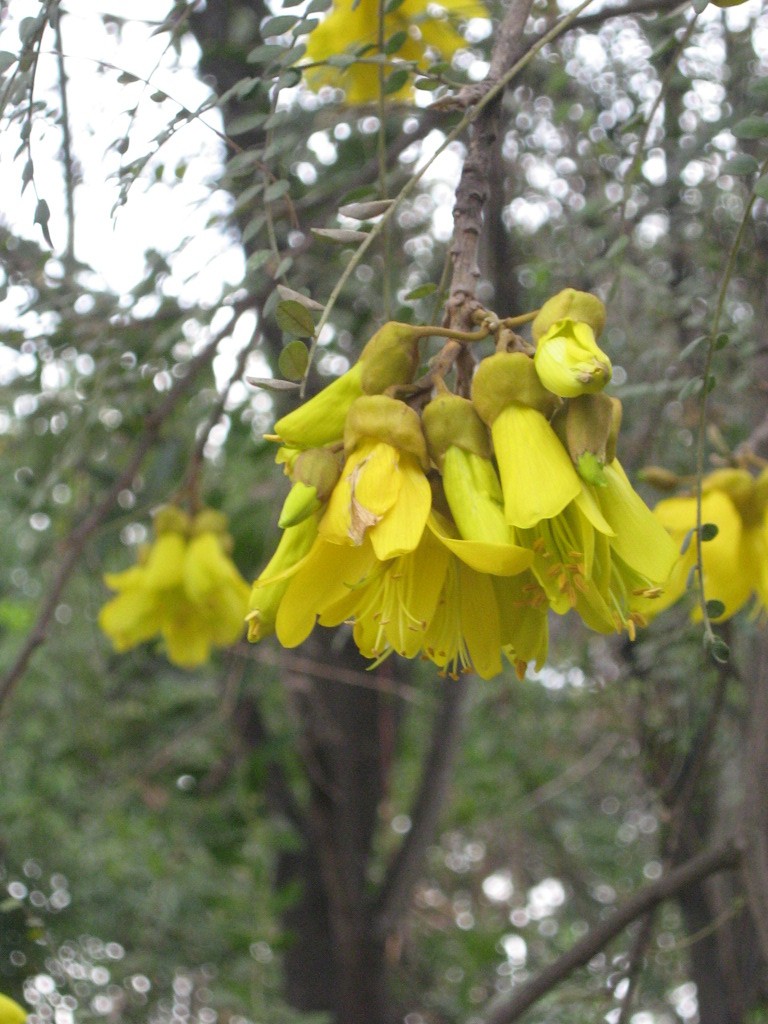- Sophora cassioides
image_width = 240px
status = NT
status_system = iucn3.1
regnum =Plant ae
divisio =Magnoliophyta
classis =Magnoliopsida
ordo =Fabales
familia =Fabaceae
genus = "Sophora "
species = "S. cassioides"
binomial = "Sophora cassioides"
binomial_authority = (Phil.) Sparre.Sophora cassioides [ [http://www.rsnz.org/publish/nzjb/2001/13.php The correct name for Chilean pelu (Fabaceae): the identity of Edwardsia macnabiana and the reinstatement of Sophora cassioides New Zealand J. Bot.39:167] ] (syn "S. macnabiana" (Grah.)Skottsb.) is legume tree native to Chile.
Taxonomy
"Sophora cassioides" has been considered in earlier treatment as "S.macnabiana" or as subspecies of "S.microphylla" Ait. ("S.microphylla" subsp. "macnabiana" Yakovlev) and even as part of the large-leaved kowhai "S.tetraptera" J.F.Mill. (e.g. "S.tetraptera" sensu Reiche).
Distribution
It is an endemic from South Chile and
Gough Island [Wace NM. 1961. The Vegetation of Gough Island Ecological Monographs, 31:337-367 ] . In South America has been gathered between Constitución and Puyuhuapi. It prefers shady places into Myrtaceae stands, besides "Drymys", "Caldcluvia" and other hygrophyllous species. Putatives hybrids with "S.macrocarpa" have been described at Bullileo (Linares). Also, into Coastal range in the association Peumus boldus-Persea lingue [Smith-Ramírez-Smith C., Armesto JJ, Valdovinos C. 2005. Historia, Biodiversidad y ecología de los Bosques costeros de Chile. editorial Universitaria]Phylogeny
"Sophora" represents a polyphyletic assemblage, the Tetraptera group (sensu Tsoong et Ma [ [http://www.plantsystematics.com/qikan/manage/wenzhang/FL19-2-1.pdf A study of genus "Sophora" Acta Phytotaxonomica Sinica 19(2): 143-167, 1981 (Chin.)] ] ) including "S.cassioides" and "S.macrocarpa" forms a monophyletic group with Eurasian species like as "S.flavescens" Ait. and Asian "S.alopecuroides" L. (syn "S.jaubertii" Spach) suggesting, a west or nor-west Pacific origin. [Michell AB & Heenan PB 2004 "Sophora" sect. "Edwardsia" (Fabaceae): further evidence from mDNA sequence data of a recent and rapid radiation aroud the Southern Oceans "Bot J. Linn. Soc." 140:435-441.] , [Hurr KA, Lockhart PJ, Heenan PB, & Penny D. 1999. Evidence for the recent dispersal of "Sophora" (Leguminosae) around the Southern Oceans: molecular data. Journal of Biogeography 26:565 ] The accepted idea that New Zealand is an Ancient continental land mass has been challenged; an isolation of 65-80 Myr is no more attainable. Geologically New Zealand is an oceanic archipelago, although comprising continental crust, that emerged 25 Myr. Chatham Islands emerged 1-3 Myr and the entire flora arrives by dispersal, 9.6-8.9 million year for "Sophora" (Hurr et al 1999), a clearer example is
Nothofagus , phylogenetic relationship between trans-Tasman species in both "Lophozonia" and "Fucospora" can only be explained by mid-to late Tertiary transoceanic dispersal (Knapp et al. 2005 [ [http://biology.plosjournals.org/perlserv/?request=get-document&doi=10.1371/journal.pbio.0030014&ct=1 PLoS Biology - Relaxed Molecular Clock Provides Evidence for Long-Distance Dispersal of Nothofagus (Southern Beech) ] ] ) [Trewick SA, Paterson AM & Campbell MJ. 2007 Hello New Zealand. [http://www.blackwell-synergy.com/doi/full/10.1111/j.1365-2699.2006.01643.x Journal of Biogeography 34:1, 1–6] .]Notes and references
ource
Heenan PB., Lange PJ de, Wilton AD. 2001. "Sophora" (Fabaceae) in New Zealand taxonomy, distribution, and biogeography. [http://www.rsnz.org/publish/nzjb/2001/3.php "New Zealand J. Bot." 39: 17-53.]
Wikimedia Foundation. 2010.

